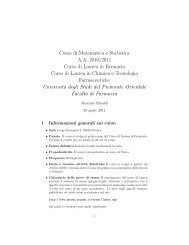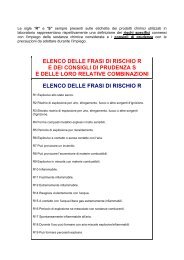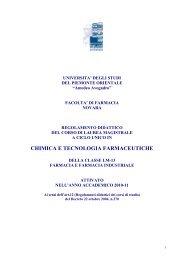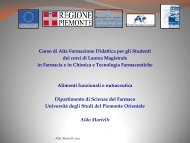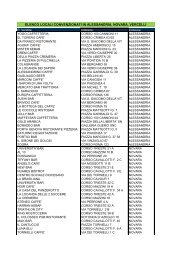Sistemi transdermici e sviluppi
Sistemi transdermici e sviluppi
Sistemi transdermici e sviluppi
You also want an ePaper? Increase the reach of your titles
YUMPU automatically turns print PDFs into web optimized ePapers that Google loves.
Prof.ssa Paola Minghetti<br />
SISTEMI TRANSDERMICI E SVILUPPI<br />
FORMULATIVI
ARGOMENTI TRATTATI<br />
Milestones nello sviluppo dei cerotti<br />
Tipi di somministrazione<br />
Definizioni di Farmacopea<br />
Razionale dei diversi tipi di somministrazione<br />
Fasi di sviluppo dei cerotti<br />
Controlli tecnologici
Milestones nello sviluppo dei cerotti<br />
Cerotti con guttaperca<br />
Sviluppo PSA<br />
in campo medico<br />
1882 1920 1960 1970<br />
Sviluppo PSA<br />
sintetici<br />
1979 1981<br />
Sviluppo dei sistemi<br />
<strong>transdermici</strong><br />
FDA approva cerotto<br />
scopolamina<br />
Il mercato crescerà a<br />
$21.5 miliardi nel 2010<br />
$31.5 miliardi nel 2015<br />
FDA approva:<br />
•Transderm-nitro<br />
•Nitro-dur<br />
•Nitrodisc<br />
Il valore del mercato globale per il rilascio transdermico è di $12.7 miliardi.
“DESTINO” DEL PRINCIPIO ATTIVO<br />
non permeare la pelle in<br />
maniera significativa<br />
Attività a livello cutaneo<br />
(medicinali ad attività cutanea,<br />
cosmetici, dispositivi medici)<br />
permeare la pelle in quantità<br />
sufficiente a raggiungere<br />
concentrazioni efficaci<br />
attività regionale o sistemica
Classificazione (FUI XII ed.)<br />
• Cerotti <strong>transdermici</strong> (emplastra transcutanea)<br />
• Preparazioni semisolide per applicazione<br />
cutanea:<br />
- Impiastri medicati
Cerotti <strong>transdermici</strong><br />
(emplastra transcutanea)<br />
I cerotti <strong>transdermici</strong> sono preparazioni<br />
farmaceutiche flessibili di varie dimensioni,<br />
contenenti uno o più principi attivi, da<br />
applicare sulla pelle integra per rilasciare il o i<br />
principi attivi alla circolazione sistemica, dopo<br />
aver attraversato la barriera cutanea.<br />
FUI XII ed.
Transdermal Systems<br />
(USP32-NF27 S1)<br />
Transdermal drug delivery systems are self-contained, discrete dosage forms that, when<br />
applied to intact skin, are designed to deliver the drug(s) through the skin to the systemic<br />
circulation. […]<br />
Transdermal drug delivery systems work by diffusion: the drug diffuses from the drug<br />
reservoir, directly or through the rate-controlling membrane and/or contact adhesive if<br />
present, and then through the skin into the general circulation. Typically, modified-release<br />
systems are designed to provide drug delivery at a constant rate, such that a true steadystate<br />
blood concentration is achieved and maintained until the system is removed. At that<br />
time, blood concentration declines at a rate consistent with the pharmacokinetics of the<br />
drug.<br />
Transdermal drug delivery systems are applied to body areas consistent with the labeling for<br />
the product(s). As long as drug concentration at the system/skin interface remains constant,<br />
the amount of drug in the dosage form does not influence plasma concentrations. The<br />
functional lifetime of the system is defined by the initial amount of drug in the reservoir and<br />
the release rate from the reservoir.<br />
NOTE—Drugs for local rather than systemic effect are commonly applied to the skin<br />
embedded in glue on a cloth or plastic backing. These products are defined traditionally as<br />
plasters or tapes
Preparazioni semisolide per applicazione cutanea<br />
Impiastri medicati<br />
Gli impiastri medicati sono preparazioni flessibili che contengono uno o più<br />
principi attivi. Sono destinati ad essere applicati alla pelle. Sono preparati per<br />
mantenere i principi attivi in stretto contatto con la pelle così che possano<br />
essere assorbiti lentamente oppure agire come protettivi e cheratolitici.<br />
Gli impiastri medicati sono costituiti da una base adesiva, che può essere<br />
colorata, contenenti uno o più principi attivi, spalmata come strato uniforme su<br />
un appropriato supporto fatto di prodotti naturali o sintetici. Non è irritante o<br />
sensibilizzante per la pelle. […]<br />
Gli impiastri medicati sono presentati in una varietà di misure adatte al loro uso<br />
previsto oppure in fogli più grandi da tagliare prima dell’uso. Aderiscono<br />
saldamente alle pelle applicando una lieve pressione e possono essere toltisenza<br />
causare danno apprezzabile alla pelle o il distacco della preparazione dallo strato<br />
esterno di supporto.<br />
FUI XII ed.
Classificazione (Eur. Ph. 6.7)<br />
• Transdermal patches<br />
• Semisolid preparations for cutaneous<br />
application:<br />
– Medicated plasters<br />
– Cutaneous patches
Trandermal patches<br />
(emplastra transcutanea)<br />
Transdermal patches are flexible pharmaceutical<br />
preparations of varying sizes, containing one or more<br />
active substances.<br />
They are intended to be applied to the unbroken skin<br />
in order to deliver the active substance(s) to the<br />
systemic circulation after passing through the skin<br />
barrier.<br />
European Pharmacopoeia 6.7
Semisolid preparations for cutaneous application<br />
Medicated plasters<br />
Medicated plasters are flexible preparations containing 1 or more active<br />
substances. They are intended to be applied to the skin. They are designed to<br />
maintain the active substance(s) in close contact with the skin such that these<br />
may be absorbed slowly, or act as protective or keratolytic agents.<br />
Medicated plasters consist of an adhesive basis, which may be coloured,<br />
containing 1 or more active substances, spread as a uniform layer on an<br />
appropriate support made of natural or synthetic material. They are not irritant or<br />
sensitising to the skin. […]<br />
Medicated plasters are presented in a range of sizes directly adapted to their<br />
intended use or as larger sheets to be cut before use. Medicated plasters adhere<br />
firmly to the skin when gentle pressure is applied and can be peeled off without<br />
causing appreciable injury to the skin or detachment of the preparation from the<br />
outer, supporting layer.<br />
European Pharmacopoeia 6.7
Semisolid preparations for cutaneous application<br />
Cutaneous patches<br />
Cutaneous patches are flexible preparations containing 1 or more active<br />
substances. They are intended to be applied to the skin. They are designed to<br />
maintain the active substance(s) in close contact with the skin such that these<br />
may act locally.<br />
Cutaneous patches consist of an adhesive basis, which may be coloured,<br />
containing 1 or more active substances, spread as a uniform layer on an<br />
appropriate support made of natural or synthetic material. The adhesive basis is<br />
not irritant or sensitising to the skin. […]<br />
Cutaneous patches are presented in a range of sizes adapted to their intended use.<br />
They adhere firmly to the skin when gentle pressure is applied and can be peeled<br />
off without causing appreciable injury to the skin or detachment of the<br />
preparation from the outer, supporting layer.<br />
European Pharmacopoeia 6.7
Somministrazione transdermica<br />
Razionale biofarmaceutico:<br />
• Migliorare la biodisponibilità del principio attivo (es.<br />
evitare l’effetto di primo passaggio; garantire livelli<br />
ematici costanti nel tempo per periodi prolungati)<br />
Razionale terapeutico:<br />
• Migliorare la “compliance”<br />
• Ridurre gli effetti indesiderati<br />
Razionale industriale<br />
Riduzione dei costi di trattamento
Somministrazione transdermica<br />
Razionale biofarmaceutico:<br />
• Migliorare la biodisponibilità del principio attivo (es.<br />
evitare l’effetto di primo passaggio; garantire livelli<br />
ematici costanti nel tempo per periodi prolungati)<br />
Razionale terapeutico:<br />
• Migliorare la “compliance”<br />
• Ridurre gli effetti indesiderati<br />
Razionale industriale<br />
Riduzione dei costi di trattamento
Biodisponibilità della nitroglicerina<br />
per diverse vie di somministrazione<br />
Concentrazione plasmatica<br />
0<br />
Sublinguale<br />
Orale<br />
2 4 6 8<br />
First North American Conference of Nitroglycerin Therapy, 27/06/1983<br />
Forma<br />
farmaceutica<br />
Insorgenza<br />
dell’azione<br />
(min)<br />
Transdermica<br />
Tempo (h)<br />
Durata<br />
d’azione<br />
Spray Sublinguale 2 - 5 10- 30 min<br />
Compressa orale RP 20 - 45 2 – 6 h<br />
Cerotto 30 - 60 fino a 24 h
Variabilità di assorbimento<br />
La maggior parte dei cerotti <strong>transdermici</strong> ha un CV<br />
compreso tra 26% (nicotina) e 53% (nitroglicerina).<br />
Per le formulazioni orali il CV è molto variabile, dal 12,3%<br />
(clonidina) al 202% (testosterone)<br />
Farahmand S. and Maibach HI, Int. J. Pharm. 367(1-2): 1-15, 2009
Somministrazione transdermica<br />
Razionale biofarmaceutico:<br />
• Migliorare la biodisponibilità del principio attivo (es.<br />
evitare l’effetto di primo passaggio; garantire livelli<br />
ematici costanti nel tempo per periodi prolungati)<br />
Razionale terapeutico:<br />
• Migliorare la “compliance”<br />
• Ridurre gli effetti indesiderati<br />
Razionale industriale<br />
Riduzione dei costi di trattamento
Case history: oxibutinina<br />
Via transdermica Via orale<br />
Oxytrol (3.9 mg/die) Ditropan XL (10 mg )<br />
AUC oxibutinina (ng/h×mL) 10.8±2.4 9.2±3.3<br />
AUC N-desetiloxibutinina/AUC<br />
oxibutinina<br />
1.2±0.3 4.1±0.9<br />
Concentrazioni plasmatiche di N-desetiloxibutinina<br />
più basse riducono l’incidenza di effetti collaterali<br />
muscarinosimili (es.: secchezza delle fauci,…)<br />
Mayo Clinic Proceedings (2003), 78(6), 696-702.
Case history: estradiolo<br />
C m,cpr: 418 pg/ml<br />
C m,patch: 35 pg/ml<br />
Somministrazione orale (2mg/die)<br />
Somministrazione transdermica (50 mg/die)<br />
Ore<br />
• La terapia orale può causare attivazione della coagulazione ed<br />
aumentare il potenziale fibrinolitico.<br />
• La somministrazione transdermica non interferisce sull’emostasi.<br />
Scarabin PY et al., Arteriosclerosis, Thrombosis, and Vascular Biology 17(11): 3071-3078, 1997
Somministrazione transdermica<br />
Razionale biofarmaceutico:<br />
• Migliorare la biodisponibilità del principio attivo (es.<br />
evitare l’effetto di primo passaggio; garantire livelli<br />
ematici costanti nel tempo per periodi prolungati)<br />
Razionale terapeutico:<br />
• Migliorare la “compliance”<br />
• Ridurre gli effetti indesiderati<br />
Razionale industriale<br />
Riduzione dei costi di trattamento
Razionale industriale<br />
• Prolungamento degli effetti economici del<br />
brevetto<br />
• Fronteggiare la sostituibilità del principio attivo<br />
(generici)<br />
• Rilancio dell’immagine di un principio attico<br />
• Alternativa agli alti costi di R&D di una “new<br />
entity”
Case history: clonidina<br />
Costi ($US)<br />
900<br />
800<br />
700<br />
600<br />
500<br />
400<br />
300<br />
200<br />
100<br />
0<br />
Cerotto transdermico Somministrazione orale<br />
f.f. Medico Lab Hosp Totale<br />
Servizio<br />
Somministrazione:<br />
• orale: 2 sommininistrazioni/die<br />
Effetti collaterali: sonnolenza, secchezza delle fauci<br />
• transdermica: 1 somministrazione/settimana<br />
Cramer MP and Saks SR, PharmacoEconomics. 5(6), 482-504, 1994.
Somministrazione regionale<br />
Razionale:<br />
• Necessità di ottenere un’azione localizzata<br />
Vantaggi vs via orale:<br />
• Concentrazioni ematiche inferiori<br />
• Livelli tissutali comparabili o maggiori
Case history: ibuprofene<br />
Somministrazione<br />
Concentrazione (ng/ h/ mL -1 )<br />
Tessuto sottocutaneo Muscolo<br />
Cutanea 731.2 ± 605.0 90.3 ± 63.5<br />
Orale 176.6 ± 122.9 213.4 ± 117.2<br />
Biodisponibilità relativa<br />
via cutanea vs via orale: 0.57% ± 0.30%
Case history: acido flufenamico<br />
ORALE<br />
Dose orale: 100 mg<br />
Dose percutanea 16,5 mg/20 cm 2<br />
APPLICAZIONE CUTANEA<br />
1. Area vicina al sito di applicazione<br />
2. Area sottostante al sito di applicazione
Somministrazione locale<br />
Nel caso di trattamenti locali:<br />
• Protezione e isolamento dell’area<br />
interessata dalla patologia<br />
• Riduzione reazioni avverse in aree non<br />
interessate dalla patologia<br />
• Dosaggio, area e tempo di applicazione<br />
• Cessione del principio attivo<br />
predeterminata Possibilità di ottenere concentrazioni tissutali del<br />
principio attivo riproducibili e costanti nel tempo
Fasi di sviluppo di un cerotto<br />
(trans)dermico<br />
Fattibilità<br />
• Permeabilità cutanea in vitro del principio attivo (celle di diffusione)<br />
• Irritazione/sensibilizzazione cutanea<br />
Sviluppo galenico<br />
• Scelta della matrice e del supporto (caratteristiche di dissoluzione,<br />
permeazione e adesione)<br />
• Stabilità<br />
• Definizione delle specifiche del prodotto (titolo, dissoluzione)<br />
Studio clinico<br />
• Farmacocinetica<br />
• Concentrazioni ematiche<br />
• Microdialisi<br />
• Stripping<br />
Efficacia e sicurezza
Fasi di sviluppo di un cerotto<br />
(trans)dermico<br />
Fattibilità<br />
• Permeabilità cutanea in vitro del principio attivo (celle di diffusione)<br />
• Irritazione/sensibilizzazione cutanea<br />
Sviluppo galenico<br />
• Scelta della matrice e del supporto (caratteristiche di dissoluzione,<br />
permeazione e adesione)<br />
• Stabilità<br />
• Definizione delle specifiche del prodotto (titolo, dissoluzione)<br />
Studio clinico<br />
• Farmacocinetica<br />
• Concentrazioni ematiche<br />
• Microdialisi<br />
• Stripping<br />
Efficacia e sicurezza
Fattibilità<br />
Permeabilità cutanea in vitro del principio attivo
Permeabilità cutanea in vitro<br />
Linee guida OECD<br />
Linee guida OECD<br />
(Organisation for Economic Co-operation and Development)<br />
• Guidance document for the conduct of skin absorption studies<br />
(March 2004)<br />
• OECD Guideline for the Testing of Chemicals. Skin Absorption: in<br />
vivo method<br />
(Guideline 427, April 2004)<br />
• OECD Guideline for the Testing of Chemicals. Skin absorption: in<br />
vitro method<br />
(Guideline 428, April 2004)
Permeabilità cutanea in vitro<br />
Linee guida OECD<br />
• OECD Guideline for the Testing of Chemicals. Skin absorption: in vitro method<br />
• (Guideline 428, April 2004).<br />
• Skin preparation<br />
• 11. Skin from human or animal sources can be used. It is recognised that the<br />
use of human skin is subject to national and international ethical considerations<br />
and conditions. Although viable skin is preferred, non-viable skin can also be used<br />
provided that the integrity of the skin can be demonstrated. Either epidermal<br />
membranes (enzymically, heat or chemically separated) or split thickness skin<br />
(typically 200-400 μm thick) prepared with a dermatome, are acceptable. Full<br />
thickness skin may be used but excessive thickness (ca. > 1 mm) should be<br />
avoided unless specifically required for determination of the test chemical in<br />
layers of the skin. The selection of species, anatomical site and preparative<br />
technique must be justified. Acceptable data from a minimum of four replicates<br />
per test preparation are required.
Permeabilità cutanea in vitro<br />
Linee guida EC<br />
Linee guida EC<br />
• Opinion on BASIC CRITERIA FOR THE IN VITRO<br />
ASSESSMENT OF DERMAL ABSORPTION OF<br />
COSMETIC INGREDIENTS - updated March 2006<br />
(Scientific Committee On Consumer Products<br />
(SCCP), SCCP/0970/06)<br />
• EUROPEAN COMMISSION<br />
• HEALTH & CONSUMER PROTECTION DIRECTORATE-<br />
GENERAL<br />
Directorate C - Public Health and Risk Assessment<br />
C7 - Risk assessment
Permeabilità cuteanea in vitro<br />
Basic criteria for the in vitro assessment of dermal<br />
absorption of cosmetic ingredients - March 2006<br />
4.13. Variability / validity / reproducibility<br />
The variability of dermal absorption studies depends on the penetration rate of a particular<br />
ingredient; the lower the penetration rate, the higher the variability. This high variability is<br />
due to known intra-individual and inter-individual characteristics of the stratum corneum<br />
barrier. The relative variability of the method should be documented.<br />
Experience has shown that the high variation in dermal absorption may partly be explained<br />
by differences in skin samples. Therefore skin samples should be taken from a suitable<br />
anatomical site and the study should use a sufficient number of samples and replicates.<br />
The technical ability of the performing laboratory and the validity of the method used<br />
should be assessed at regular intervals, at least twice per year, by using reference<br />
compounds like caffeine or benzoic acid. These data should be included in the study report<br />
[OECD 2004, Van de Sandt et al. 2004].<br />
The results of the dermal absorption studies should be reproducible. A minimum of 6<br />
evaluable samples (human or pig skin), from each of at least 3 donors, should be used per<br />
dose tested. The coefficient of variation should be less than 30 %. If statistical evaluation is<br />
not possible, the highest observed penetration value will be used in the systemic exposure<br />
dosage (SED) calculation.
Permeabilità cuteanea in vitro<br />
Stima della permeabilità cutanea in vivo di un API<br />
Principio attivo<br />
Cl<br />
(L/h)<br />
C ss<br />
(ng/ml)<br />
C t/C ss<br />
ITF 296 138.6 2.02 0.37 2.47<br />
NR 52.2 1.07 0.23 140.19<br />
ISDN 224.4 0.44 0.01 10.23<br />
NTG 300.0 0.61 0.11 1.15<br />
Minghetti P. et al., Eur J Pharm Sci 7(3):231 –236, 1999.<br />
C<br />
ss<br />
J<br />
max<br />
TTS<br />
Cl<br />
area<br />
Concentrazioni allo stato stazionario (C ss) calcolate<br />
in base ai valori di J max ottenuti sperimentalmente
Permeabilità cuteanea in vitro<br />
Selezione del sale<br />
Cilurzo F. et al., J. Pharm. Sci. DOI: 10.1002/jps.21891, 2009
Permeabilità cutenea in vitro<br />
Selezione di un eventuale enhancer<br />
Terpinen-4-ol permeated amount ( g/cm 2 )<br />
9000<br />
8000<br />
7000<br />
6000<br />
5000<br />
4000<br />
3000<br />
2000<br />
1000<br />
0<br />
TTO<br />
PEG400<br />
IPM<br />
TR<br />
OA<br />
0 4 8 12 16 20 24<br />
Time (h)<br />
Casiraghi A. et al., Pharmaceutical Development and Technology, DOI 10.3109/10837450903338387, 2009<br />
Acido oleico<br />
Olio di malaleuca
Fasi di sviluppo di un cerotto<br />
(trans)dermico<br />
Fattibilità<br />
• Permeabilità cutanea in vitro del principio attivo (celle di diffusione)<br />
• Irritazione/sensibilizzazione cutanea<br />
Sviluppo galenico<br />
• Scelta della matrice e del supporto (caratteristiche di dissoluzione,<br />
permeazione e adesione)<br />
• Stabilità<br />
• Definizione delle specifiche del prodotto (titolo, dissoluzione)<br />
Studio clinico<br />
• Farmacocinetica<br />
• Concentrazioni ematiche<br />
• Microdialisi<br />
• Stripping<br />
Efficacia e sicurezza
Scelta della matrice e del supporto<br />
Design dei cerotti trandermici:<br />
• <strong>Sistemi</strong> “reservoir”<br />
• <strong>Sistemi</strong> a matrice polimerica<br />
• <strong>Sistemi</strong> “microreservoir”
Cerotti <strong>transdermici</strong><br />
<strong>Sistemi</strong> “reservoir”<br />
Membrana<br />
polimerica<br />
“Reservoir”<br />
Strato adesivo<br />
Supporto
Cerotti <strong>transdermici</strong><br />
<strong>Sistemi</strong> a matrice polimerica doppio strato<br />
Supporto<br />
Supporto<br />
Matrice polimerica che<br />
controlla il rilascio del p.a.<br />
<strong>Sistemi</strong> a matrice polimerica monostrato<br />
Strato adesivo<br />
Matrice polimerica autoadesiva<br />
che controlla il rilascio del p.a.
Ibuprofen amount permeated mg/cm (<br />
2 )<br />
120<br />
100<br />
Scelta della matrice<br />
80<br />
60<br />
40<br />
20<br />
Ruolo della matrice nell’assorbimento<br />
0<br />
0 4 8 12 16 20 24<br />
Time (h)<br />
Polyaminomethacrylate<br />
Poly(acrylatevinylacetate)<br />
P.Minghetti, et al., Acta Technologiae et Legis Medicamenti, XII, 3: 199-212, 2001. .<br />
Ibuprofen release amount<br />
100<br />
90<br />
80<br />
70<br />
60<br />
50<br />
40<br />
Form. 1<br />
Form. 2<br />
0 4 8<br />
tempo (ore)
Ketoprofen amount permeated (mg/cm 2 )<br />
Scelta della matrice<br />
800<br />
700<br />
600<br />
500<br />
400<br />
300<br />
200<br />
100<br />
0<br />
Time 0<br />
Time 7 days<br />
Time 21 days<br />
0 4 8 12 16 20 24<br />
Time (h)<br />
Ju Hyun et al., Int. J. Pharm. 236: 81-85, 2002.
amount permeated (mg/cm 2 )<br />
Scelta della matrice<br />
180<br />
160<br />
140<br />
120<br />
100<br />
80<br />
60<br />
40<br />
20<br />
Ruolo della matrice nell’assorbimento<br />
Ex vivo human skin permeation of ibuprofen patches<br />
BIO-PSA<br />
BIO-PSA + E100<br />
BIO-PSA + RS100<br />
0<br />
0 4 8 12 16 20 24<br />
Time (h)<br />
Cilurzo et al., Eur. J. Pharm. Biopharm. 60: 61–66, 2005.
Quantità permeata<br />
Scelta del supporto<br />
120<br />
100<br />
80<br />
60<br />
40<br />
20<br />
3073-C supporto: COTRAN<br />
3073-P supporto: polietilene<br />
0 4 8 12 16 20 24<br />
tempo (ore)<br />
Minghetti P. et al., Pharm. Develop. Technology, 12(3), 239-246, 2007.<br />
Patch di oxybutinina
Scelta del supporto<br />
Tipo di cerotto<br />
occlusivo<br />
Ridotta<br />
Modificabile<br />
Breve<br />
Dimensione<br />
Sito di applicazione<br />
Tempo di applicazione<br />
non<br />
occlusivo<br />
Elevata<br />
Non modificabile<br />
Prolungato
Scelta della matrice e del supporto<br />
Condizioni operative:<br />
• Temperatura = 37±0,5 °C<br />
• Tempo = 24 h<br />
Permeabilità al vapor d’acqua (WVP)<br />
Coperchio<br />
• WVP = (perdita in peso*1000g/m 2 /24h)/13.2<br />
Minghetti P. et al., Int. J. Pharm, 158: 165-172, 2007.<br />
Supporto/Cerotto<br />
Riserva d’acqua
Scelta della matrice e del supporto<br />
Permeabilità al vapor d’acqua (WVP)<br />
TEWL: 9.02.1 g/m 2 /h (n=60).<br />
Matrix Backing layer Coating thickness<br />
Casiraghi A. et al., Pharm Res, 19(4) (2002) 423-426<br />
(μm)<br />
WVP*<br />
(g/m 2 /24h<br />
)<br />
TEWL**<br />
(g/m2/h<br />
)<br />
Polyaminometacrylate PVC 250 141±4 22.6±6.3<br />
Polyacrylvynilacetate PU 500 289±23 17.6±6.8<br />
Polyacrylvynilacetate PU 250 451±11 16.7±7.4<br />
Polyaminometacrylate PU 500 1182±53 12.2±5.6<br />
Polyaminometacrylate PU 250 1432±38 9.7±2.6<br />
Note: *n= 5; **n= 12<br />
TEWL = - 0.01 WVP + 21.31<br />
(R 2 =0.9312 F=40.63 p=0.0078)
Definizione delle specifiche di prodotto<br />
Saggi tecnologici<br />
TRANDERMAL PATCHES<br />
• Uniformità delle unità di dosaggio<br />
(2.9.40)<br />
• o, se giustificato ed autorizzato,<br />
saggio per l’uniformità di<br />
contenuto – saggio C- (2.9.6)<br />
• Saggio di dissoluzione per i cerotti<br />
<strong>transdermici</strong> (2.9.4)<br />
(FUI XII edIzione, 2009)<br />
MEDICATED PLASTERS e CUTANEOUS<br />
PATCHES<br />
Nessun saggio obbligatorio<br />
Possibilità di scelta tra:<br />
• Uniformità delle unità di dosaggio<br />
(2.9.40)<br />
• Uniformità di contenuto delle forme<br />
farmaceutiche a dose unica (2.9.6)<br />
• o altro<br />
Può essere richiesto Saggio di<br />
dissoluzione per i cerotti <strong>transdermici</strong><br />
(2.9.4)<br />
Ph. Eur. 6.7<br />
Saggio per la verifica delle proprietà adesive
Definizione delle specifiche di prodotto<br />
Dissolution test for transdermal patches<br />
This test is used to determine the dissolution rate of the active ingredient(s) of<br />
transdermal patches:<br />
• DISK ASSEMBLY METHOD<br />
metodo dell’apparecchio a disco<br />
• CELL METHOD<br />
metodo della cella<br />
• ROTATING CYLINDER METHOD<br />
metodo del cilindro rotante<br />
Il metodo va scelto sulla base delle caratteristiche del sistema terapeutico.<br />
European Pharmacopoeia 6.7
Definizione delle specifiche di prodotto<br />
Metodo dell’apparecchio a disco<br />
Disco<br />
Adesivo<br />
Cerotto transdermico
Definizione delle specifiche di prodotto<br />
Metodo del cilindro rotante<br />
Adesivo<br />
Cerotto transdermico
Definizione delle specifiche di prodotto<br />
Cerotto<br />
Metodo della cella (Ph.Eur 6.7)<br />
Dadi<br />
Perni<br />
Supporto<br />
Coperchio<br />
Membrana
Definizione delle specifiche di prodotto<br />
Cerotto<br />
Metodo della cella (versione modificata)<br />
Minghetti P. et al., Drug Dev. Ind. Pharm., 25(5): 679-684, 1999<br />
Dadi<br />
Coperchio<br />
Membrana<br />
Perni<br />
Supporto<br />
Guarnizione
MATRICE ADESIVA<br />
Il rilascio del principio<br />
attivo<br />
deve assicurare<br />
Il contatto con la pelle<br />
per il periodo richiesto<br />
….many prescribing<br />
information sheets for TDDS<br />
state that adhesion has not<br />
been studied……<br />
Eur. J Pharm Biopharm 64 (2006) 1-8
Segnalazioni ricevute da FDA riguardanti la perdita di<br />
adesività di cerotti <strong>transdermici</strong><br />
– Perdita di efficacia<br />
– Aumento dei costi<br />
–Problemi di sicurezza<br />
Eur. J Pharma Biopharm 64 (2006) 1-8
Definizione delle specifiche di prodotto<br />
Adesività del cerotto<br />
“Tack”<br />
indice della velocità con cui si instaura il legame<br />
tra il cerotto e la superficie di un altro materiale.<br />
“Shear adhesion” o “Creep resistance”<br />
fornisce indicazioni sulle proprietà coesive della matrice.<br />
“Peel adhesion”<br />
forza necessaria per rimuovere il cerotto<br />
da una determinata superficie.
Definizione delle specifiche di prodotto<br />
Resistenza al distacco: modalità di distacco
Definizione delle specifiche di prodotto<br />
Saggio di resistenza al distacco<br />
Peel rate<br />
(mm/min)<br />
Patch 1<br />
(cN/cm ± SD)<br />
Minghetti P. et al., Eur. J. Pharm. Sci., 10(2): 111-117, 2000<br />
Patch 2<br />
(cN/cm ± SD)<br />
100 294 42 450 167<br />
300 499 22 642 143<br />
Velocità di distacco:<br />
300 mm/min : riferimento metodi standardizzati<br />
100 mm/min : riferimento per il distacco in vivo
Definizione delle specifiche di prodotto<br />
Resistenza al distacco: materiale della piastra<br />
Peel Force (cN/cm)<br />
600<br />
500<br />
400<br />
300<br />
200<br />
100<br />
0<br />
Stainless Steel Plate<br />
Polyethylene Plate<br />
1 2 3 4 5<br />
Form. no.<br />
Minghetti P. et al., Drug Dev. Ind. Pharm. 25(1): 1–6, 1999.
Definizione delle specifiche di prodotto<br />
Peel Force<br />
(cN/cm)<br />
Resistenza al distacco: influenza del supporto<br />
500<br />
450<br />
400<br />
350<br />
300<br />
250<br />
200<br />
150<br />
100<br />
50<br />
0<br />
artificial silk<br />
poliuretano<br />
1 2 3 4 5<br />
Minghetti P. et al., Drug Dev. Ind. Pharm. 25(1): 1–6, 1999.<br />
Peel adhesion 180° test values with polyethylene plate
Definizione delle specifiche di prodotto<br />
Resistenza al distacco: influenza dello spessore
Fasi di sviluppo di un cerotto<br />
(trans)dermico<br />
Fattibilità<br />
• Permeabilità cutanea in vitro del principio attivo (celle di diffusione)<br />
• Irritazione/sensibilizzazione cutanea<br />
Sviluppo galenico<br />
• Scelta della matrice e del supporto (caratteristiche di dissoluzione,<br />
permeazione e adesione)<br />
• Stabilità<br />
• Definizione delle specifiche del prodotto (titolo, dissoluzione)<br />
Studio clinico<br />
• Farmacocinetica<br />
• Concentrazioni ematiche (transdermal patches)<br />
• Microdialisi (medicated plasters)<br />
• Stripping (cutaneous patches)<br />
Efficacia e sicurezza
μg/cm2 2<br />
coumarin pemeated in vitro<br />
Correlazione ex-vivo / in vitro della cumarina caricata su 2 differenti<br />
matrici con la stessa quantità di meliloto estratto secco<br />
18<br />
15<br />
12<br />
9<br />
6<br />
3<br />
0<br />
3 h<br />
1 h<br />
y = 0,8193x - 2,9155<br />
R 2 = 0,9727<br />
5 h<br />
7 h<br />
0 4 8 12 16 20 24<br />
μg/cm 2 coumarin permeated ex vivo<br />
24 h<br />
Minghetti P. et al., Eur. J. Pharm. Sci., 10(2): 111-117, 2000<br />
μg/cm 2 coumarin pemeated in vitro<br />
18<br />
15<br />
12<br />
9<br />
y = 1,021x - 2,9605<br />
R 2 = 0,9835<br />
24 h<br />
6<br />
3<br />
5 h<br />
3 h<br />
7 h<br />
0<br />
1 h<br />
0 4 8 12 16 20<br />
μg/cm 2 coumarin permeated ex vivo
Medicinali con le stesse prestazioni<br />
possono avere differente:<br />
• Design<br />
• Contenuto di principio attivo (totale, per<br />
cm 2 )
Cerotti in commercio contenenti<br />
nitroglicerina<br />
Cerotto<br />
Contenuto<br />
(mg)<br />
Superficie<br />
(cm 2 )<br />
Permeato dichiarato<br />
(mg/24h)<br />
Deponit 37.4 18.0 10<br />
Minitran 36.0 13.0 10<br />
Triniplas 44.8 14.0 10<br />
Nitroderm 50.0 20.0 10
NTG mg/ 24 h<br />
Prestazioni di diversi cerotti<br />
contenenti NTG<br />
Assorbimento in vivo<br />
Rilascio in vitro<br />
Shah V.P. et al., Eur J Pharm Biopharm 41(3): 163-167, 1995<br />
NTG rilasciata (mg)<br />
90<br />
80<br />
70<br />
60<br />
50<br />
40<br />
30<br />
20<br />
10<br />
0<br />
0 4 8 12 16 20 24<br />
tempo (h)<br />
Nitro dur<br />
Transderm nitro<br />
Minitran<br />
Deponit
Prestazioni di diversi cerotti<br />
contenenti NTG<br />
Proprietà adesive<br />
Cerotto<br />
Resitenza allo scorrimento<br />
(min)<br />
Resistenza al distacco<br />
(cN/cm)<br />
Deponit 6±3 264±5<br />
Minitran 75±18 117±7<br />
Triniplas 9±4 229±13<br />
Minghetti P. et al., Boll. Chim. Farm. 140(2): 63-67, 2001.




